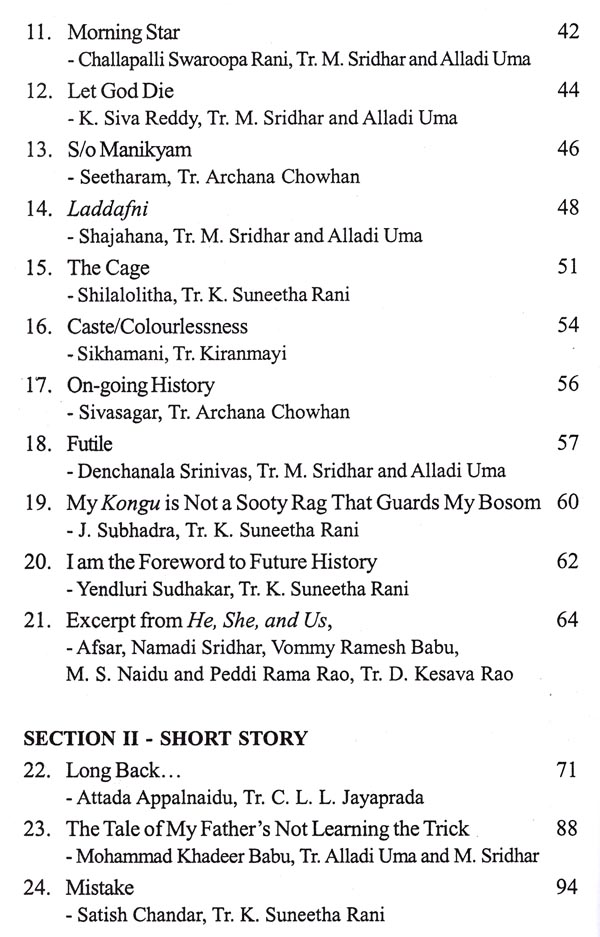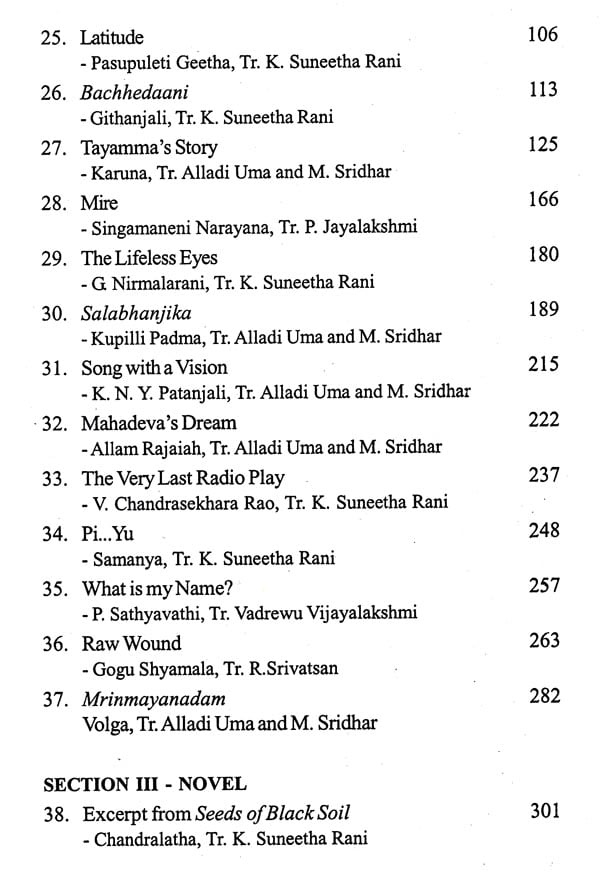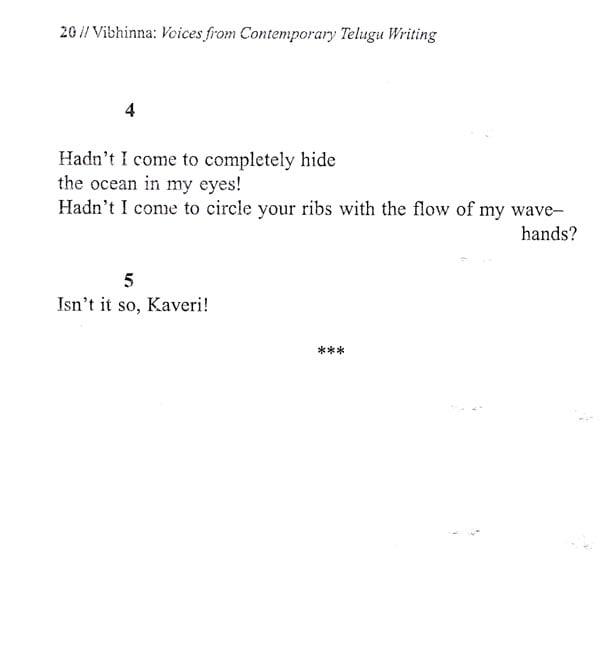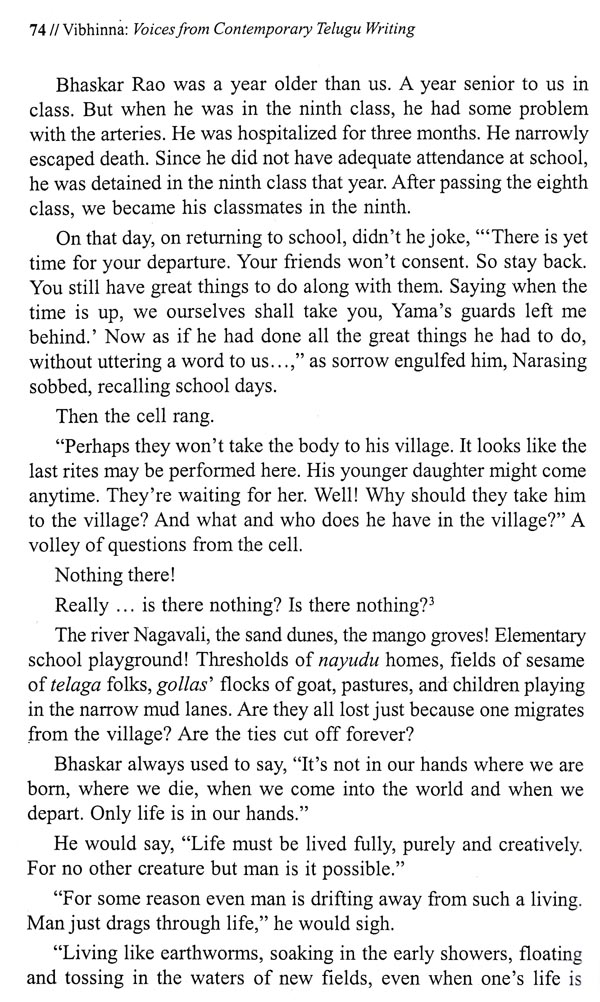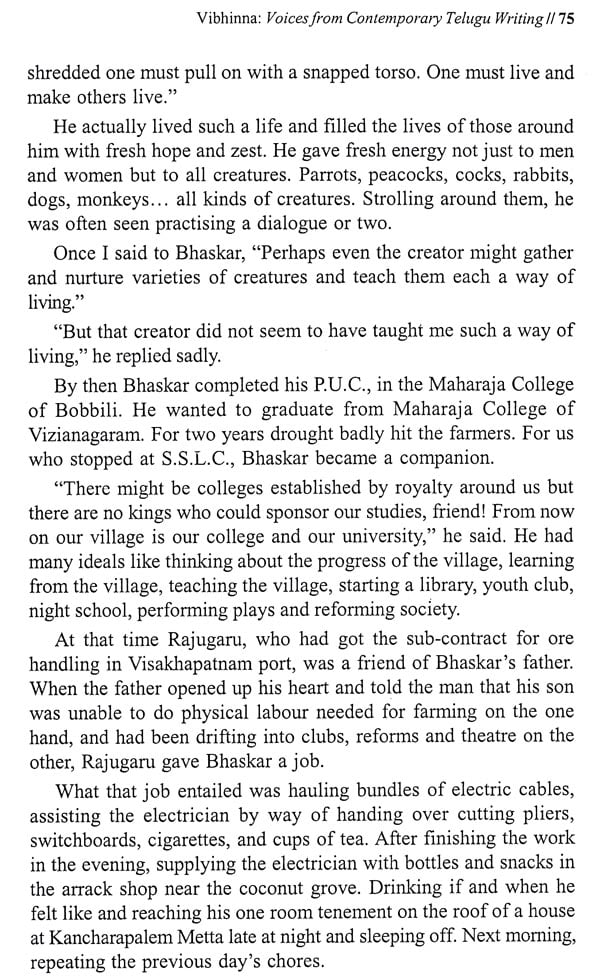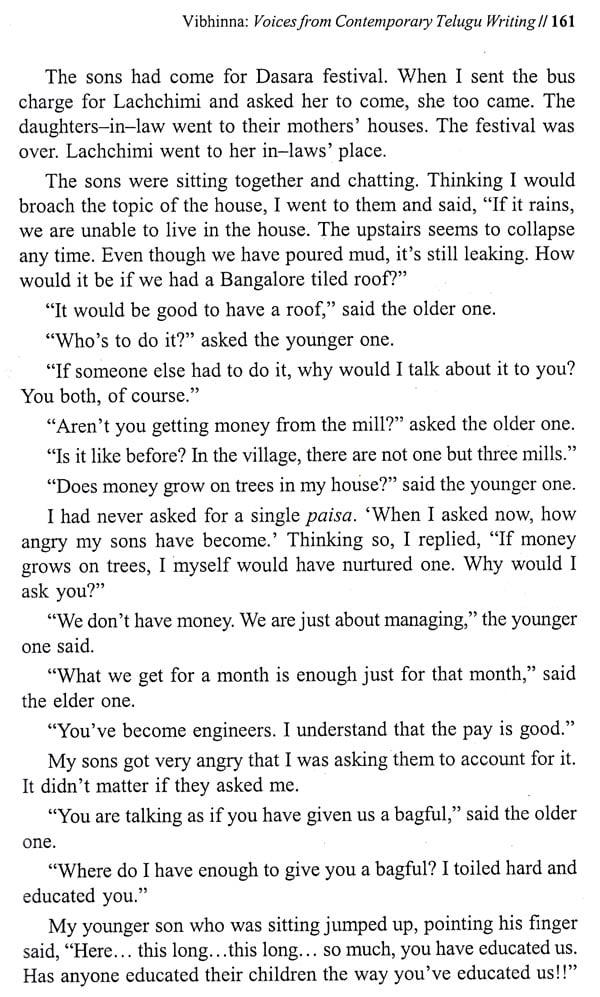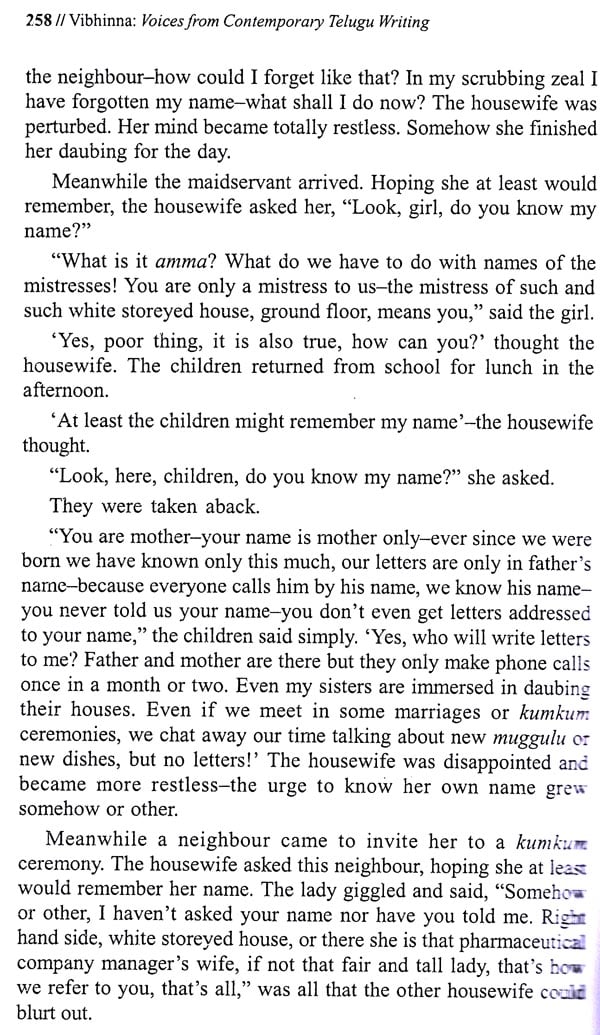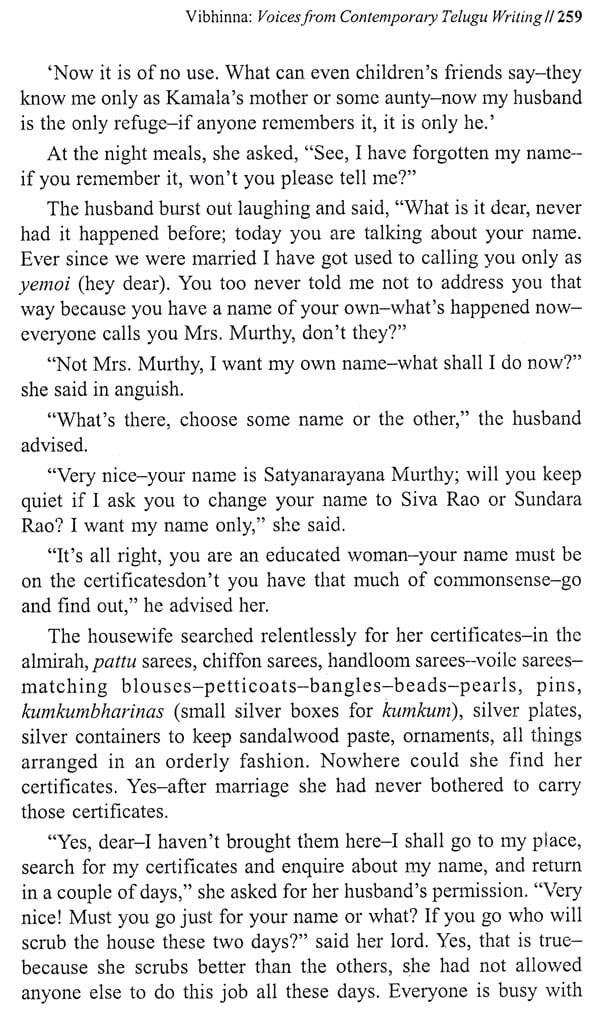
Vibhinna (Voices from Contemporary Telugu Writing)
Book Specification
| Item Code: | NAR492 |
| Author: | Alladi Uma, M. Sridhar and K. Suneetha Rani |
| Publisher: | Sahitya Akademi, Delhi |
| Language: | English |
| Edition: | 2015 |
| ISBN: | 81260483660 |
| Pages: | 406 |
| Cover: | PAPERBACK |
| Other Details | 8.50 X 5.50 inch |
| Weight | 520 gm |
Book Description
Vibkinna: Voices from Contemporary Telugu Writing attempts to showcase a literature that has been. vibrant and alive. It represents a range of styles and literary movements that have dominated the Telugu scene in the last three decades. It brings to the attention of the English readers some of the best creative minds who have written poetry, short stories, novels and critical pieces.
How Many Voices to a Vibrant Literature!' How does one describe a literature of about a quarter of a century in a matter of a few pages? How does one describe a literature that has been very vibrant and alive and responsive to every literary, socio-political movement and event? How does one characterize a literature that has always absorbed literary forms, conventions and movements from outside the country, but domesticated them for its own sake and purpose? It is very difficult, but nevertheless....
Telugu has had long phases of movement literature, "left" movement being the dominant movement in the 70s. 1970 marks the birth of Virasam (Revolutionary Writers' Association). It attempted to redefine the nature of poetry, the role of the poet and the very purpose of poetry. It advocated free verse and people's language. The poet was required to emphasize the collective experience. But it had to later answer the complaint of becoming too formulaic and curbing the authentic individual experiences of the writers Imposition of political emergency and curbing of people's civil liberties took place during this decade of revolutionary poetry.
The poems represented of Gaddar and K. Siva Reddy in this anthology have been written more recently, but they certainly reflect a clear "left" ideology. The poets who stormed the Telugu scene in the mid 60s with their "Digambara" (Naked) poetry continued to write during the above period. The Digambara poets found the available modes of poetic expression extremely inadequate and discovered a voice of their own that expressed itself in stark and naked ways, and in a language that was considered "obscene" by "polite" standards. Apart from poets who had clearly aligned themselves with one group or the other, there had been powerful, individual voices that defied categorization and wrote poetry that was highly personal. The poetry of the 80s represented a tension between the ideology of the collective good represented by the poetry from the "left" circles and the strongly felt need to give free vent to the poet's individual creative expression by the Anubhutivada poets and others. Vegunta Mohan Prasad had in his own distinct way fought against any regimentation of conventional poetic expression. There had also been poets who had moved away from their "left" inclinations and experimented with poetic form. The collective poem by Afsar, Namadi Sridhar, Vommy Ramesh Babu, M. S. Naidu and Peddi Rama Rao at the end of the poetry section here may be seen as representing to some extent such a trend.
The 90s represented the emergence of the literature of "identities," a direct offshoot of the personal, social and political questions that bothered specific groups. Women, particularly from the middle and upper classes were the first to voice their concerns arising from the constraints imposed on them by the family and the patriarchal society. Jayaprabha, Kondepudi Nirmala, Ghantasala Nirmala, Vimala, Patibandla Rajani, S. Jaya and Shilalolita are among the most powerful women poets. During this period there were two notable attempts to put together anthologies of women's poetry-Gurichoosipade Pata (Song That is Directly Aimed) edited by Tripuraneni Srinivas in 1990 and Neelimeghalu (Dark Clouds) edited by Volga and Vasanth Kannabiran in 1993. These collections mark a significant departure both in terms of subject and poetic expression. Women had uninhibitedly talked about subjects hitherto proscribed, like the pain associated with menstrual cycle and childbirth, celebration of the body etc., in images, metaphors and language, all their own. They had to publish poetry of this kind against severe restrictions within the family and strong criticism from the poetic establishment.
This decade was also witness to the birth of the Dalit and Muslim Minority voices. These two literary movements brought to light a host of young writers and some senior writers who have now written with a distinct consciousness of their origin and place in a caste-ridden and communal Hindu society. The Dalit movement stormed the Telugu literary scene with two significant collections-Chikkanavutunna Pata edited by Lakshmi Narasaiah and Tripuraneni Srinivas (1995) and Padunekkina Pata (1996) edited by Lakshmi Narasaiah. At this juncture, the Dalit literary movement encompassed an entire gamut of social categories such as the SCs, STs, the BCs and religious Minorities, The movement in the later years gave rise to literary movements emphasizing specific caste configurations and identities like the Backward Castes, the Minorities and the Sub-Castes within the SCs. These identitarian movements of specific groups brought to the fore some powerful individual voices like Sivasagar, Gopi, Yendluri Sudhakar, Sikhamani, Juluru Gowrishankar, Madduri Nagesh Babu, Denchanala Srinivas, Seetharam, Annavaram Devender, Challapalli Swaroopa Rani and Jupaka Subhadra. Though Muslims and other Backward Castes initially contributed to these volumes and came together under the larger definition of the Dalit, they soon found the need to express themselves in terms of their separate and distinct identities. Each distinct identity also contributed to the growing corpus of Telugu writing with its own anthologies of poetry and the short story. For the Muslims the demolition of the Babri Masjid provided the need to assert their identity. Jihad, a collection put together by Virasam on behalf of the Muslims and Zalzala edited by Sky Baba from within the community are significant in this context. Khaja, Yakoob, Mahe Jabeen and Shajahana are some of the prominent poets among them. Many of the Muslim writers are converts from the Backward Classes and who speak Telugu (not Urdu) to assert their specific cultural and linguistic identity. Afsar seems to chart a course distinctly his own, even as he continues to write with a clear Muslim identity too. The Madiga and other sub-castes among the SCs responded to the SC sub-categorization issue through some of its most powerful proponents. An attempt to examine their status in relation to others within their own Dalit community in terms of the benefits of reservation brought to focus the Madiga identity both in literature and politics.

